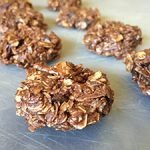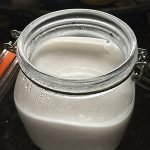If you have not tried coconut yoghurt, you do not know what you are missing out on. Not only is it a great cultured food, which means it has live cultures and is beneficial to your gut health; it also tastes fantastic. You can purchase coconut yoghurt in stores but if you want to save a few dollars and can spare 10-15 minutes, then try making it yourself. It is simple.
The one special equipment you need is a thermos as the yoghurt needs to incubate for 12-18 hours at a constant temperature of 40°C. Alternatively, you could wrap the container with a tea towel and put it in the oven with just the light on. A cooking thermometer will give you the exact temperature of your liquid but your fingers are a pretty good gauge if you don’t have one.
Ingredients:
- 800ml coconut milk
- 3 tablespoon yoghurt with live cultures (I used goat’s milk yoghurt. However, if you cannot tolerate dairy, then you could use yoghurt cultures or store-bought coconut yoghurt made with live cultures.)
- 1 tablespoon arrowroot (for thickening)
Instructions:
- Put coconut milk in a saucepan and slowly bring it to almost boiling, about 85°C. You need to keep a close eye on it and give it a few stirs. This step is to kill off any bacteria that may work against the yoghurt making bacteria.
- Take your saucepan off the heat and allow to cool to 45°C. If you are using your fingers as your thermometer, the coconut milk should feel slightly warm.
- Put the arrowroot in a cup and mix it with the yoghurt, then add a few tablespoons of the cooled but slightly warm coconut milk into this mixture. Once well mixed, pour this mixture into the saucepan of coconut milk and stir through.
- The coconut milk mixture needs to be poured into a container or a thermos to ‘incubate’ for 12-18 hours. If the mixture is poured into a container, wrap it with a tea towel and leave it in an oven with just the light on. Do not disturb it during this time.
- The magic happens after the incubation period is up. You will find that the coconut milk has thickened and when you taste it, it tastes like yoghurt. The live culture has done its job and you have made yoghurt. If you used a thermos, transfer the yoghurt to a container and put it in the fridge to halt the culturing process. The yoghurt is ready to eat. Enjoy!



